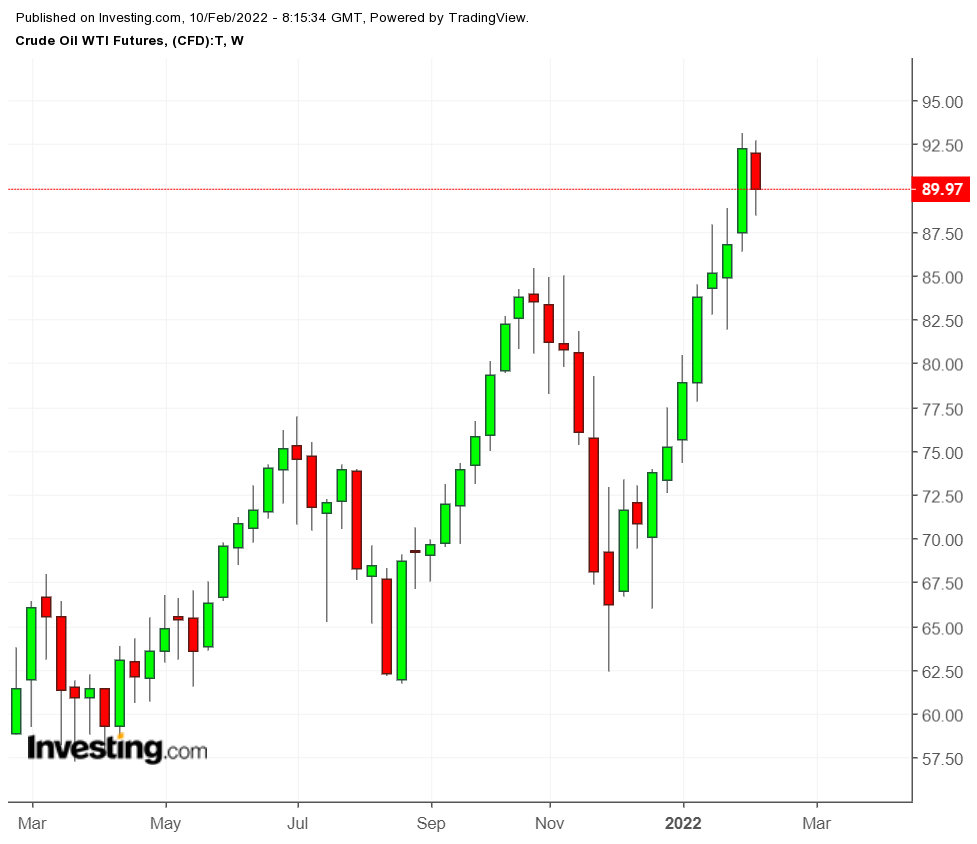Tensions in Eastern Europe are helping keep oil prices elevated, but the big story in geopolitics and oil this week is the state of negotiations between the U.S. and Iran. According to U.S. diplomats, talks between the two countries are progressing to a “critical stage.”

Markets seem to be interpreting this news as an indication that a final deal could be coming. The assumption is that that would mean sanctions relief. On Tuesday, oil prices dropped over 2% on news of further talks between the U.S. and Iran.
How likely is sanctions relief?
It seems unlikely that this current round of talks will result in a complete resolution and a new nuclear agreement between the U.S. and Iran because of the number of issues that still must be resolved.
U.S. negotiators have yet to meet face-to-face with their Iranian counterparts, and they continue to conduct all talks through intermediaries. That said, some Iran analysts are very optimistic that a new nuclear agreement is imminent and point out that both sides are highly motivated to conclude the negotiations.
It is possible we could see the end of all or some sanctions even before a final nuclear deal is done. The Biden administration has long maintained that oil sanctions can only be ended with the signing of a new nuclear agreement. However, there are indications that this resolve could be crumbling. The Biden administration may consider relaxing sanctions before a final agreement.
On Feb. 4, Secretary of State Blinken signed several sanctions waivers associated with civilian nuclear projects in Iran. These waivers will allow foreign countries and companies working on Iran’s civilian nuclear projects to avoid penalties associated with U.S. sanctions. Even though these waivers have nothing to do with oil, the fact that the U.S. signed them without any concessions from Iran could be an indication that we could further see minimization of oil sanctions sometime soon.
The Biden administration seems desperate to lower global oil prices and gas processing in the U.S. It is facing political pressure to do something to alleviate these high oil prices.
In late November 2021, the Biden administration tried to bring down gasoline prices for American consumers in time for the holidays by arranging a coordinated release of oil from the strategic petroleum reserves (SPRs) of a variety of countries. The effort failed to impact oil and gasoline prices, though the announcement of the Omicron variant did cause a significant drop in prices shortly thereafter.
Providing oil sanctions relief to Iran could be a quick way to increase global oil supplies and facilitate a drop in oil prices.
How much oil could Iran realistically add to the market?
Over the past year, Iran’s crude and condensate exports have ranged from a high of 1.65 million bpd in March 2021 to a low of 746,000 bpd in May 2021. Recently, Iran has been averaging exports of about 1.37 million bpd. (Data on Iranian exports provided by TankerTrackers.com). During the Trump administration, after President Trump reinstated sanctions in 2018, Iran’s exports fell to a low of about 200,000 bpd.
Before Trump reinstated oil sanctions, Iran’s oil exports hit 2.8 million bpd, according to TankerTrackers.com. According to Rystad Energy, Iran could begin to increase its production—and, therefore, the amount of crude and condensate on the global market—within 4-6 months of sanctions relief.
In contrast, the National Iranian Oil Company (NIOC) claimed in June 2021 that if sanctions were lifted, Iran could restore its oil production to 3.8 million bpd within one month. Oil traders would be wise to trust third-party analysts over the Iranian government.
If the sanctions were to end, Iran could also immediately sell oil from its floating storage, which currently stands at about 87 million barrels of oil just waiting to go to market, according to Kpler.
Goldman Sachs estimates that if a deal with Iran was signed next month, it would take until Q3 2022 for enough Iranian oil to come on the market to impact prices. However, Goldman’s commodities research analysts remain more skeptical than the Iran analysts that a deal is likely to materialize in the short term. (Goldman Sachs Commodities Research Note Feb. 8, 2022)
How will developments likely impact oil prices?
News of an agreement would send oil prices down in anticipation of increased supply. However, the dip is likely to reverse as the news cycle digests the deal, because there remain significant forces pushing prices up (inflation, U.S government environmental policies, the Russia/Ukraine scenario and potential alleviation of virus-induced low demand).
Goldman Sachs predicts that if a deal is signed in March 2022, Iranian oil exports would increase enough by Q3 2022 that it could lower its own price forecasts by $7 per barrel.
In addition, Iran’s production capacity is not the only obstacle to returning Iranian oil to the global market. Many buyers in countries like Japan, Turkey, India, and South Korea will be reluctant to commit to cargoes of Iranian oil, because insurance and payment issues will still need to be worked out. It may take several months before these former customers feel comfortable making financial arrangements with Iran.
Because the sanctions relief is likely to come from executive action, some foreign buyers will also be hesitant to resume relations with Iran unless they are sure that a new President (potentially elected in 2024) won’t simply scrap this deal like Trump did, when he took office in 2018.
